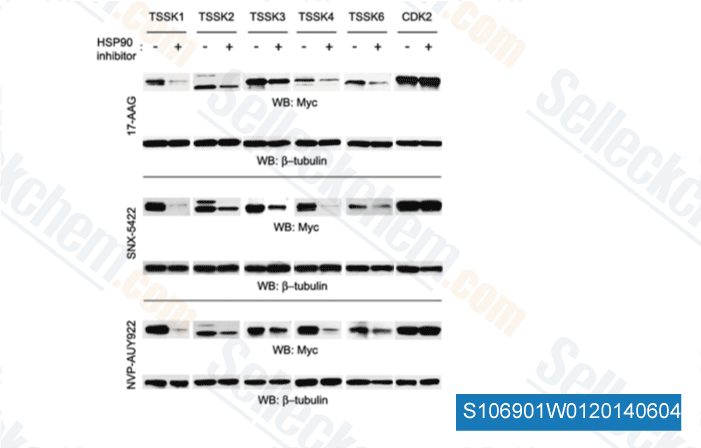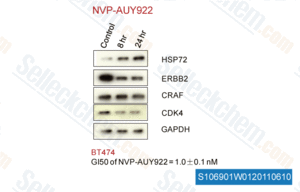|
Toll Free: (877) 796-6397 -- USA and Canada only -- |
Fax: +1-832-582-8590 Orders: +1-832-582-8158 |
Tech Support: +1-832-582-8158 Ext:3 Please provide your Order Number in the email. |
Technical Data
| Formula | C26H31N3O5 |
|||
| Molecular Weight | 465.54 | CAS No. | 747412-49-3 | |
| Solubility (25°C)* | In vitro | DMSO | 93 mg/mL (199.76 mM) | |
| Ethanol | 93 mg/mL (199.76 mM) | |||
| Water | Insoluble | |||
|
* <1 mg/ml means slightly soluble or insoluble. * Please note that Selleck tests the solubility of all compounds in-house, and the actual solubility may differ slightly from published values. This is normal and is due to slight batch-to-batch variations. * Room temperature shipping (Stability testing shows this product can be shipped without any cooling measures.) |
||||
Preparing Stock Solutions
Biological Activity
| Description | Luminespib (AUY-922, NVP-AUY922, VER-52296) is a highly potent HSP90 inhibitor for HSP90α/β with IC50 of 13 nM /21 nM in cell-free assays, weaker potency against the HSP90 family members GRP94 and TRAP-1, exhibits the tightest binding of any small-molecule HSP90 ligand. Luminespib (AUY-922, NVP-AUY922) effectively downregulates and destabilizes the IGF-1Rβ protein and results in growth inhibition, autophagy and apoptosis. Phase 2. | ||||
|---|---|---|---|---|---|
| Targets |
|
||||
| In vitro | NVP-AUY922 inhibits proliferation of various human cancer cell lines in vitro, with an average GI50 of 9 nM. [1] The IC50 values of NVP-AUY922 fall in the range of 2 to 40 nM in these gastric cancer cell lines. IC50 value for the BEAS-2B cells is 28.49 nM. Treatment with NVP-AUY922 does not influence the expression of HSP90, but expression of HSP70 gets elevated by NVP-AUY922 treatment. NVP-AUY922 increases the binding of HSP70 to HSP90. NVP-AUY922 causes p23 dissociation from the HSP90 complex and can then recruit HSP70 to the HSP90 complex. [1] After the treatment with NVP-AUY922, expression of receptor tyrosine kinases including VEGFR1, 2, 3 and PDGFRɑ is decreased. A decrease is also noticed in the expression of Akt and phospho-Akt. Meanwhile, treatment with NVP-AUY922 causes decreased expression of HER-2 in NCI-N87 cells. NVP-AUY922 treatment results in binding of HSP90 to client proteins and setting them up as targets for degradation by the proteasome. NVP-AUY922 can influence cell growth by affecting multiple signaling pathways. In addition, treatment with the proteasome inhibitor, MG132, restores expression of thymidylate synthase, which is decreased by NVP-AUY922. NVP-AUY922 increases the expression of cleaved caspase-3 leading to apoptosis in HSC-2 cells.[1] | ||||
| In vivo | Treatment with NVP-AUY922 causes a robust antitumor response and inhibits p-Akt and VEGF expression in an HSC-2 xenograft model. [2] In BT474, NVP-AUY922 shows complete loss of ERBB2 and substantial depletion of ERα, in addition to reductions in CDK4 and phospho-ERK1/2. [3] |
Protocol (from reference)
| Kinase Assay:[3] |
|
|---|---|
| Cell Assay:[1] |
|
| Animal Study:[3] |
|
References
|
Customer Product Validation

-
Data from [J Biol Chem, 2013, 288(23), 16308-20]

-
, 2011, Dr. Swee Sharp and Professor Paul Workman from Cancer Research UK
-S106910Y0120150923.gif)
-
Data from [Data independently produced by , , Proc Natl Acad Sci USA, 2014, 111(15): E1528–37 ]
Selleck's Luminespib (NVP-AUY922) has been cited by 116 publications
| Individualized Pooled CRISPR/Cas9 Screenings Identify CDK2 as a Druggable Vulnerability in a Canine Mammary Carcinoma Patient [ Vet Sci, 2025, 12(2)183] | PubMed: 40005944 |
| Activity-based protein profiling and global proteome analysis reveal MASTL as a potential therapeutic target in gastric cancer [ Cell Commun Signal, 2024, 22(1):397] | PubMed: 39138495 |
| HSP90 inhibition suppresses tumor glycolytic flux to potentiate the therapeutic efficacy of radiotherapy for head and neck cancer [ Sci Adv, 2024, 10(8):eadk3663] | PubMed: 38394204 |
| The pharmacogenomic assessment of molecular epithelial-mesenchymal transition signatures reveals drug susceptibilities in cancer cell lines [ bioRxiv, 2024, 10.1101/2024.01.16.575190] | PubMed: none |
| HSP90β Impedes STUB1-Induced Ubiquitination of YTHDF2 to Drive Sorafenib Resistance in Hepatocellular Carcinoma [ Adv Sci (Weinh), 2023, 10.1002/advs.202302025] | PubMed: 37515378 |
| HSP90β Impedes STUB1-Induced Ubiquitination of YTHDF2 to Drive Sorafenib Resistance in Hepatocellular Carcinoma [ Adv Sci (Weinh), 2023, 10(27):e2302025] | PubMed: 37515378 |
| HRS mediates tumor immune evasion by regulating proteostasis-associated interferon pathway activation [ Cell Rep, 2023, 10.1016/j.celrep.2023.113352] | PubMed: 37948180 |
| Single-cell trajectory analysis reveals a CD9 positive state to contribute to exit from stem cell-like and embryonic diapause states and transit to drug-resistant states [ Cell Death Discov, 2023, 9(1):285] | PubMed: 37542044 |
| Single-cell trajectory analysis reveals a CD9 positive state to contribute to exit from stem cell-like and embryonic diapause states and transit to drug-resistant states [ Cell Death Discov, 2023, 9(1):285] | PubMed: 37542044 |
| Single-cell trajectory analysis reveals a CD9 positive state to contribute to exit from stem cell-like and embryonic diapause states and transit to drug-resistant states [ Cell Death Discov, 2023, 9(1):285] | PubMed: 37542044 |
RETURN POLICY
Selleck Chemical’s Unconditional Return Policy ensures a smooth online shopping experience for our customers. If you are in any way unsatisfied with your purchase, you may return any item(s) within 7 days of receiving it. In the event of product quality issues, either protocol related or product related problems, you may return any item(s) within 365 days from the original purchase date. Please follow the instructions below when returning products.
SHIPPING AND STORAGE
Selleck products are transported at room temperature. If you receive the product at room temperature, please rest assured, the Selleck Quality Inspection Department has conducted experiments to verify that the normal temperature placement of one month will not affect the biological activity of powder products. After collecting, please store the product according to the requirements described in the datasheet. Most Selleck products are stable under the recommended conditions.
NOT FOR HUMAN, VETERINARY DIAGNOSTIC OR THERAPEUTIC USE.
